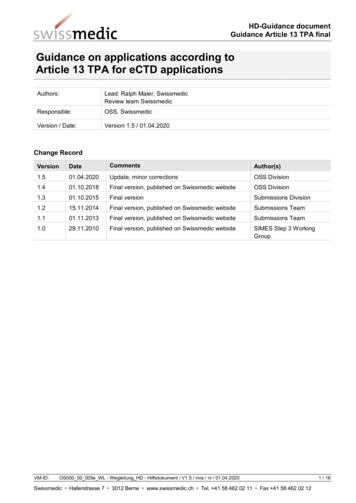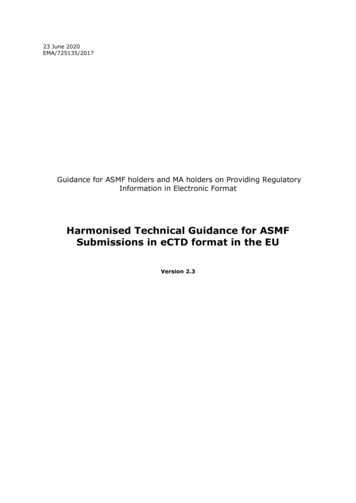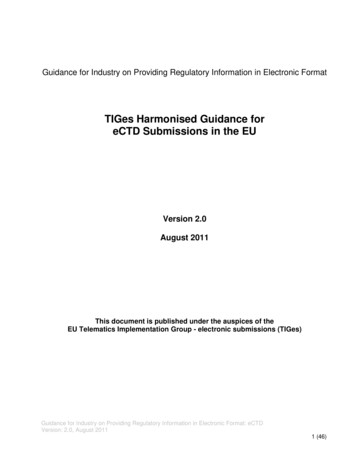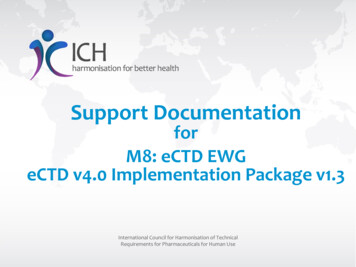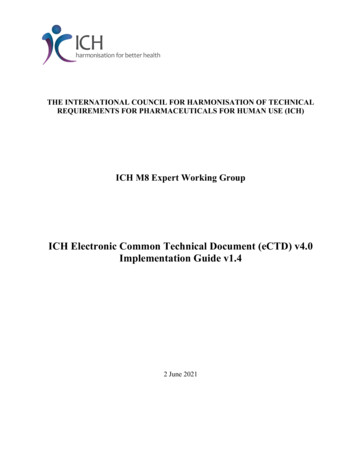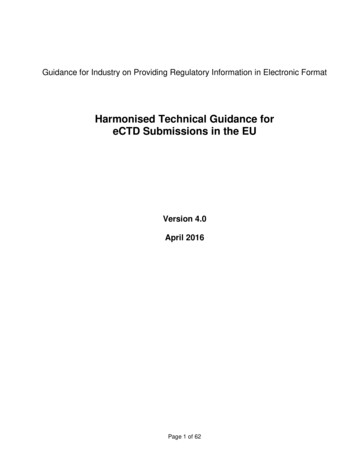
Transcription
Guidance for Industry on Providing Regulatory Information in Electronic FormatHarmonised Technical Guidance foreCTD Submissions in the EUVersion 4.0April 2016Page 1 of 62
Table of ContentsTable of Contents . 2List of Tables . 4List of Figures. 41. INTRODUCTION.51.1Glossary . 62. GENERAL CONSIDERATIONS .72.1Scope . 72.2Structure of Submissions . 72.3Transitional Arrangements. 82.4Moving to eCTD Format from Paper or NeeS Type Applications . 82.5General Submission Considerations. 92.6Correspondence . 102.7Paper Requirements. 102.8Hardware. 102.9General Technical eCTD Information . 102.10Other Technical Information . 162.11Number of Media Requested . 192.12Technical Baseline Applications . 193. MODULE SPECIFIC INFORMATION . 233.1General Information . 233.2Module 1 eCTD Envelope, Administrative Information and Prescribing Information Folder233.3Module 2 Overviews and Summaries Folder . 273.4Module 3 Quality Folder . 273.5Module 4 Nonclinical Study Reports Folder . 273.6Module 5 Clinical Study Reports Folder . 284. ADVICE ON SPECIFIC APPLICATION TYPES . 294.1New MA Applications. 294.2Variation Applications . 304.3Extension Submissions . 324.4Renewal Submissions . 324.5PSURs . 334.6Referrals. 344.7Active Substance Master Files . 354.8Vaccine Antigen Master Files . 354.9Plasma Master Files (PMFs) and medicinal products containing PMFs . 364.10Applicant Initiated Withdrawals of the MA or certain strengths, dosage forms . 364.11Applicant Withdrawal or Agency Rejections of Post-Authorisation Regulatory Activities364.12Publication of Clinical Data for Medicinal Products . 374.13Duplicate Applications and Informed Consent Applications . 37ANNEX 1: ECTD REFERENCE DOCUMENTS . 38ANNEX 2: GUIDANCE ON TEXT SEARCHABLE DOCUMENTS . 39A2-1General . 39A2-2Documents that Must Always Be Text Searchable . 39A2-3Documents that Do Not Need to Be Text Searchable . 40A2-4Further Information . 40ANNEX 3: GUIDANCE AND BEST PRACTICE ON THE STRUCTURE OF MODULE 3 . 41A3-1Introduction . 41Technical eCTD Guidance v4.0Page 2 of 62
A3-2General Principles . 42A3-3Module 3 XML Attributes in the eCTD . 44ANNEX 4 – MANAGEMENT OF PARALLEL VARIATIONS IN THE ECTD . 54A4-1Background . 54A4-2Business Challenge . 54A4-3Best Practice . 54A4-4Description of Figures. 55Technical eCTD Guidance v4.0Page 3 of 62
List of TablesTable 1 : Example of a PSUSA. 12Table 2 : Example of a Referral for CAPs . 12Table 3 : Example of a Referral for NAPs . 12Table 4 : Repeatable Elements and Attributes that Define Different Sections . 13Table 5 : Example for starting an eCTD with a baseline sequence . 19Table 6 : Example for starting an eCTD with regulatory activity sequence . 20Table 7 : Examples of Filenames and Leaf Titles for Response Documents. 26Table 8 : MAA – Centralised Procedure . 29Table 9 : Centralised Procedure - Outside eCTD via EudraLink . 30Table 10 : New MAA – Decentralised Procedure . 30Table 11 : Type II Variations – Centralised Procedure . 30Table 12 : Type IA & IB Variations – Centralised Procedure . 31Table 13 : Type IB Variations with linguistic review - Centralised Procedure . 31Table 14 : Renewals . 33Table 15 : Centralised Procedure – Outside eCTD via EudraLink . 33Table 16 (A3) : Advantages and disadvantages of eCTD application structures . 42List of FiguresFigure 1 : Sample of folder structure. 15Figure 2 (A3) : Single Drug Substance, 2 Manufacturers with similar documentation, the fewsite/manufacturer-specific documents are identified by the XML title (not by adding an additional XMLsection): . 46Figure 3 (A3) : Single Drug Substance, 2 Manufacturers with significant volume of differentdocumentation (one section for Acme Chemicals, another for Pharmasupply) . 48Figure 4 (A3) : Approach 1 – One 32p for all Strengths, any strength specific documents identified bythe XML title, not by adding an additional XML section . 50Figure 5 (A3) : Approach 2 - Separate XML elements and documents for Strengths – significantcontent differences, but Pharmaceutical Development only provided once in the folder structure andreferred to from the XML twice . 52Figure 6 (A4): Description of elements . 55Figure 7 (A4) : Use of one document lifecycle . 55Figure 8 (A4) : Use of separate document lifecycles with different title attributes . 57Figure 9 (A4) : Replacement of approved content by newly approved content, and deletion ofproposed content. 57Figure 10 (A4) : Progression on the 2nd Parallel Proposal . 59Figure 11 (A4) : Replacement of approved content by newly approved content, and deletion ofmultiple proposed documents . 60Technical eCTD Guidance v4.0Page 4 of 62
1.INTRODUCTIONThis guidance document is intended to assist pharmaceutical companies with the submission of regulatoryinformation in electronic Common Technical Document format (eCTD) to the National Competent Authorities(hereafter referred to as NCAs) and the European Medicines Agency (hereafter referred to as EMA). The eCTDformat is regarded as the principal electronic submission format in EU for human medicinal products and is theonly electronic format that is accepted by the EMA (except for some specified procedures) and is stepwisebecoming mandatory within the Decentralised, Mutual Recognition Procedures and purely National Proceduresas well depending on national decisions. However, the Non eCTD electronic Submissions (NeeS) format is stillaccepted within these procedures and for National Procedures and therefore a guidance document for NeeS isalso published on the EMA eSubmission website.This guidance was initially created by the TIGes Harmonisation Group, a sub-group of the TelematicsImplementation Group for electronic submissions (TIGes), and is now being maintained by the HumanHarmonisation Maintenance Group (HHMG), a sub-group of the eSubmission Change Management Board(CMB).It should be stressed that this guidance reflects the current situation and will be regularly updated in the light ofchanges in national and/or European legislation together with further experience gained within NCAs and EMAusing information submitted in electronic format. If needed, there are also Q&A documents published inbetween versions of this guidance as a response on change requests or new requirements to be addressed(see EMA eSubmission website)This document consists of four parts: Introduction, General Considerations, Module Specific Information andAdvice on Specific Application Types together with associated annexes.Technical eCTD Guidance v4.0Page 5 of 62
1.1GlossaryA brief glossary of terms (for the purpose of this document only) is indicated below:TermDefinitionApplicantA pharmaceutical company or its agent that is submitting information insupport of an application.Regulatory information submitted by an applicant for, or to maintain, amarketing authorisation that falls within the scope of this guidancedocument.A collection of electronic documents compiled by a pharmaceuticalcompany or its agent in compliance with European legislation andguidelines in order to seek a marketing authorisation or anyamendments thereof. An eCTD application may comprise a number ofregulatory activities. In the EU an eCTD application may compriseseveral dosage forms and strengths, all under one invented productname. This is understood to be equivalent to a Global MarketingAuthorisation according to Art. 6 para 2 Dir. 2001/83/EC as amended.A Community registration procedure for the authorisation of medicinalproducts in the European Community. There are 4 types of procedurethat operate within the EC – Centralised, Decentralised, MutualRecognition and National.A single sequence or a collection of sequences covering the start tothe end of a specific business process, e.g. an MA application or TypeII variation. To allow a more precise handling, the regulatory activity willbe classified using a controlled vocabulary (submission type orregulatory activity type) and a free text field for a short narrativedescription.A single set of information and / or electronic documents submitted atone particular time by the applicant as a part of, or the completeapplication .Any collection of content assembled in accordance with theeCTD specification (ICH and EU) will be described using metadata asdefined by the EU envelope. Sequences may be related to one anotherwithin one regulatory activity. The related sequence number shouldalways be stated. In case of activities with only one sequence the samesequence number will be used.The submission type describes the regulatory activity to which thecontent will be submitted.The submission unit type element of the envelope metadata setdescribes the content at a lower level (a “sub-activity”) which issubmitted in relation to a defined regulatory activity such as the initialsubmission, the applicant response to validation issues or list ofquestions or any other additional information.Applicant’s InformationeCTD application or alsoknown as a dossierProcedureRegulatory ActivitySequenceSubmission TypeSubmission Unit TypeTechnical eCTD Guidance v4.0Page 6 of 62
2.GENERAL CONSIDERATIONS2.1Scope2.1.1Types of ProductThis guidance covers the submission of electronic regulatory information for all human medicinal productsfalling within the competence of NCAs in the EEA as well as the EMA. This includes but is not limited toprescription, over the counter medicines, innovative and generic product submissions. The product typesinclude for example small molecules, biotech products, herbals, vaccines, homeopathics or blood products.2.1.2Types of SubmissionThis guidance applies to all submissions related to the authorisation and maintenance of medicinal products,including new marketing authorisations, variations, renewals, PSURs (including PSUR Single AssessmentPSUSA), active substance master files (ASMF), Plasma Master Files (PMF) and withdrawals, submission ofredacted clinical trial reports as well as any kind of paediatric submissions and referral related or postauthorisation measures related submissions. For variations, PSUSAs, ASMF and PMF there are also specificguidance documents (see references in Part 4).2.1.3Types of Submission UnitsThis allows sequences to be grouped together that make up a Regulatory Activity. The submission unit willdescribe the sub-activity within a Regulatory Activity, such as initial, validation-response, response and closingin case of a new MAA.The submission unit ‘additional-info’ should be used for additional information (which could include, forexample, missing files), and should only be used when ‘validation-response’ or ‘response’ is not suitable. Thesubmission type ‘corrigendum’ should only be used in exceptional circumstances in the CP to correctinformation, typically for product information, after the Regulatory Activity has concluded.2.1.4Types of ProceduresThis guidance covers applications made in any of the applicable Community procedures (National, MutualRecognition, Decentralised and Centralised). For submissions within MRP and DCP, please refer to thespecific CMDh guidance ‘Requirements on submissions for New Applications within MRP, DCP or Nationalprocedures’2.1.5ExceptionsThis guidance does not apply to the electronic submission of pre-marketing authorisation (MA) information suchas scientific advice, clinical trial applications, orphan drug designations, PIP submissions and relatedsubmission correspondence as well as dossier content explicitly excluded from the commonly maintainedelectronic dossier. These exceptions may be subject to change in the future. (Please refer to the EMA websiteand to CMDh website on eSubmission for the BPG and Q&As for further exceptions.)2.2Structure of SubmissionsThis document provides guidance on how to organise application information for electronic submission usingthe eCTD specifications. Guidance on the detailed information to be included is described in the CommonTechnical Document (CTD), and relevant ICH and EU Q&A documents.The structure and organisation of an eCTD submission is defined by the following standards: ICH M2 eCTD SpecificationEU Module 1 SpecificationRelevant ICH and EU Q&A docsAnnex 1 contains links to the currently approved version of these documents.Technical eCTD Guidance v4.0Page 7 of 62
Typically, an eCTD application will cover all dosage forms and strengths of a product. In the centralisedprocedure, this will be equivalent to all dosage forms and strengths covered by an EMA application number(e.g. EMEA/H/C/000123). In MRP/DCP, a single eCTD application should preferably be used for the procedure.However if an applicant decides not to apply for all strengths and dosage forms in every member state in theprocedure, the possibility of having one eCTD application per strength/dosage form should be considered.Applicants should carefully consider what an eCTD application should cover before submitting the firstsequence, as the choice could have implications for workload for the lifespan of the product. For example, if theapplicant decides to have one eCTD per strength or dosage form, it is expected that each of these eCTDapplications will be maintained individually, such that submission of a single sequence that covers more thanone strength or dosage form will no longer be possible if very good reasons are not presented for a changeover. In these rare cases, please contact the NCA/RMS/EMA concerned at an early planning stage.For further details on the pros and cons of the different approaches to dossier structure, see Table 16 (A3):Advantages and disadvantages of eCTD application structures.Please check for specific NCA guidance when preparing national eCTDs. However, note that the selection ofseparate lifecycles for national (MRP/DCP/NP) products will mean in practice that submissions for EU PSURSingle Assessment must be made for each product separately in accordance with the existing dossier structure(for details see Section 4.5).2.3Transitional ArrangementsThe specifications mentioned in Section 2.2 above will change over time and are likely to affect both eCTDbuilding tools and the applicant’s internal business processes as well as the agencies review tools andprocesses. Once a new specification has been agreed and endorsed by the appropriate EU body, eCTDbuilding tools will need to be updated. Specific transitional guidance will be provided on each occasion that theICH and/or EU specifications are updated.Please note that it should not be necessary to reformat and resubmit previously submitted applications toreflect such changes.2.4Moving to eCTD Format from Paper or NeeS Type ApplicationsChanging format from paper or NeeS to eCTD can be done at a start of any regulatory activity such as anextension, a renewal or a variation, ideally when no other regulatory activities are on-going for that product inanother format. A baseline submission is recommended at the time of changing to eCTD (see Section 2.12.) togive the agencies access to all or at least part of the previously submitted documentation within the eCTDlifecycle. When the eCTD lifecycle is initiated and accepted by the authorities, all further submissions related tothat product dossier should from that day be submitted in eCTD format. This may also include submissionsconcerning other ongoing regulatory activities related to that eCTD application (e.g. responses to questions toongoing variations), in which case, it will obviously not be possible to use the related sequence attributecorrectly since the start of the regulatory activity is not present as an eCTD sequence to refer to and thereforethe validation criterion 14 BP2 will not be met. This should be reflected in the cover letter.If the dossier has already been provided in NeeS format, the applicant should submit the new data in eCTDformat starting the lifecycle in accordance with eCTD specifications. The first submission in eCTD format willnormally be sequence 0000, even if sequential numbers were used for the NeeS format. For clarity, the coverletter should always explicitly state that the submission involves a switch to eCTD format. As the documentsalready exist in an electronic format, it would be preferable to first re-send the currently valid documents,especially module 3, as a baseline eCTD dossier in sequence number 0000 and then the first new regulatoryactivity as 0001. Please see Section 2.12 for further information on the content of baseline applications and theacceptability of scanned documents.If an applicant has been submitting applications in eCTD format to some agencies within MRP or DCP whenpaper or NeeS were still requested by some other NCAs – in the context of the switch to eCTD format of theseremaining paper/NeeS-based agencies, it would be of help if applicants would submit all former eCTDsequences in connection to a new regulatory activity for that product. The “old” eCTD sequences should beTechnical eCTD Guidance v4.0Page 8 of 62
provided together with this new eCTD sequence and it should be clearly stated in the cover letter to theconcerned NCAs that the “old” sequences have the same content as formerly submitted paper or NeeS formatdocuments. When submitting earlier sequences to other agencies, no changes to envelopes or metadata isrequired, it is accepted that the envelopes might not be entirely correct for agencies receiving a sequencepreviously submitted to another agency. Any historical sequences should not be technically validated by theagencies receiving them for the first time, for details see the CMDh guidance ‘Requirements on submissions forNew Applications within MRP, DCP or National procedures’. However, if there are problems with loading orreading the “old” files, the applicant should assist in solving the technical problems on the sequences tofacilitate their use in the “new” NCA, for example due to mistakes in transmission or creating the submission orproblems with the XML, which can be resolved without affecting future lifecycle.In any case, a tracking table is essential to understand the sequencing of your eCTD submission (please referto Section 3.2.3).Where the change from paper or NeeS to eCTD format for a product dossier is planned to be done inconnection to a repeat use procedure (i.e. for the complete dossier), the change of format should first be madein the RMS and the “original” CMSs by submitting the current dossier as a so called baseline dossier (seeSection 2.12), before the start of the repeat use procedure in the new CMSs.2.5General Submission Considerations2.5.1Document GranularitySubmissions are a collection of documents and each document should be provided as a separate file. Thedetailed structure of the eCTD should conform to the ICH Granularity Document and EU M1 specification.Careful consideration is needed when deciding the level of Module 3 granularity (please refer to Annex 3,Section 3.1)2.5.2File NamingThe eCTD file naming conventions described in the ICH M2 eCTD Specification and EU Module 1 Specificationare highly recommended, as best practice. If an applicant wishes to submit multiple files in one section, whereonly one highly recommended name is available, this can be achieved using a suffix to the filename, such asusing the file name-var.pdf convention as described in the EU Module 1 Specification (e.g. pharmaceuticaldevelopment-container.pdf). The variable part of the name must not contain “illegal” characters.File names, including the extension, must not exceed 64 characters. Also folder names must not exceed 64characters and the total file folder path length must not exceed 180 characters. Counting starts from the firstdigit of the sequence number in the sequence number folder name.For further guidance on file naming, please refer to the “File-Folder Structure & Names” work sheet included inthe current validation criteria2.5.3Placement of DocumentsGuidance on the placement of documents within the eCTD structure for particular submission types can befound in the EU-CTD Notice to Applicants and/or in the EMA post-authorisation guidance for centralisedapplications.In the submission structure, leaves should typically be placed at the lowest level of the CTD structure, althoughthere are some exceptions to this guidance, for example, in 32p4-contr-excip, where the files excipients.pdf,excipients-human-animal-var.pdf or novel-excipients-var.pdf can be placed alongside folders containing detailsof other excipients. The lowest levels of the CTD structure (including node-extensions) must contain at leastone leaf, although this should normally be managed automatically by the eCTD building tool.Technical eCTD Guidance v4.0Page 9 of 62
Every leaf must have a value for the ‘title’ attribute.2.6CorrespondenceThe eCTD is designed to ensure that users have a current view of the information submitted in the appropriateplace in the dossier at all times. Therefore, formal responses to questions should always be submitted in eCTDformat, as well as any correspondence that relates directly to the content of the dossier.In addition to the eCTD application, information may need to be exchanged to assist the processing or handlingof the application. If this correspondence is not directly relevant to the application dossier then it should not beincluded in the eCTD. This is because the eCTD exchange is currently one way only, from applicant toauthority. Other correspondence should be exchanged outside the eCTD via the usual electronic means (email,EudraLink etc.).2.7Paper RequirementsSome NCAs may still require paper copies of some documents in addition to the eCTD; refer to the CMDhguidance ‘Requirements on submissions for New Applications within MRP, DCP or National procedures’ forfurther details.2.8HardwareNCAs and the EMA will not accept any hardware (laptops, desktops, external hard drives etc.) from applicantsin connection with the submission of information in electronic format. The electronic information should bedirectly readable and usable on NCAs and EMA hardware and software.2.9General Technical eCTD Information2.9.1Identifier for ApplicationsTo help enable archiving the sequence with the correct dossier (eCTD lifecycle), applicants must state a uniqueidentification of the dossier in the form of a UUID. The identifier must be defined with the first sequence of anew dossier (or the first sequence using EU M1 version 3.0 or later), and it must be consistent throughout theeCTD lifecycle. The identifier must be changed if – and only if – the eCTD lifecycle is restarted. Examples ofthis are addressed in Section 2.12.3.The UUID is a 32 digit (8 4 4 4 12) hexadecimal string, for example: “123e4567-e89b-12d3-a456426655440000”. When defining a UUID the string should be decided at random. The string should contain noinformation referring to any other metadata. This is to ensure consistency even if the relevant metadata shouldchange. The chance of two different dossiers having the same UUID is next to none if the UUIDs are trulydefined at random.2.9.2File FormatsIn general terms the majority of documents included in electronic submissions should be in PDF format (seenext section on the use of PDF file versions). Files that might be requested by NCAs or the EMA in MS Wordformat should not be included in the eCTD structure (refer to Section 2.9.10).Further detailed guidance on file formats can be found in the ICH eCTD specification document and EU Module 1specification.Technical eCTD Guidance v4.0Page 10 of 62
2.9.3Portable Document Format (PDF)Portable Document Format (PDF) is an ISO standard (ISO 19005-1:2005 Document management – Electronicdocument file format for long-term preservation – Part 1: Use of PDF 1.4 (PDF/A-1) and ISO 32000-1:2008Document management – Portable docume
Guidance for Industry on Providing Regulatory Information in Electronic Format . Harmonised Technical Guidance for . eCTD Submissions in the EU . Version 4.0
